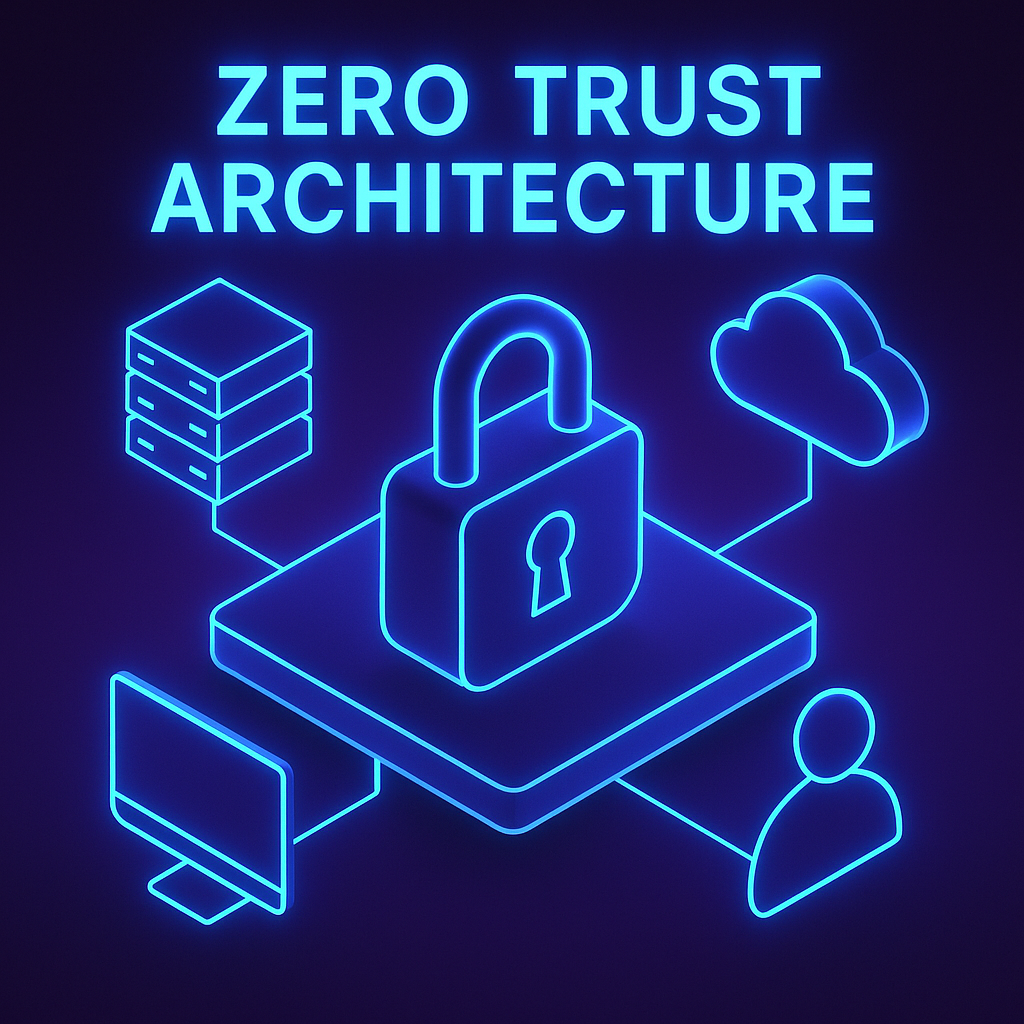For years, enterprise security operated on a simple assumption: if you were inside the corporate network, you could be trusted. Firewalls and VPNs defined the perimeter, and once inside, traffic often flowed freely. That model worked – until it didn’t.
Today’s reality is hybrid and multi-cloud. Employees connect from home, workloads run across AWS, Azure, and GCP, and applications talk to each other over APIs more than through traditional servers. Attackers don’t need to storm the gates; they just need one stolen credential or one misconfigured resource to move laterally across your environment.
This is the problem Zero Trust Architecture (ZTA) was designed to solve. Instead of assuming trust based on network location, ZTA requires verification for every request, every time. The principle is simple but radical: “Never trust, always verify.”
This article explains what Zero Trust Architecture is, why it matters now, how it works according to NIST SP 800-207, and what it takes to implement it in real-world environments.
Why Zero Trust Now
Zero Trust isn’t just another buzzword. It’s a response to very real shifts in technology and threat landscapes.
Drivers of Zero Trust Adoption
Hybrid and Multi-Cloud Growth
Organizations rarely rely on one environment anymore. A typical enterprise might run ERP on-premises, customer apps in AWS, analytics in Azure, and development pipelines in GCP. Static, perimeter-based models can’t provide consistent protection across this sprawl.
Work-from-Anywhere
The pandemic accelerated remote work, and hybrid models are here to stay. The old approach of funneling everyone through a VPN to “enter the castle” no longer scales.
Advanced Threats
Ransomware, supply chain attacks, and credential theft exploit lateral movement. Once attackers are inside, traditional segmentation often fails to contain them.
Regulatory Pressure
Frameworks like PCI DSS, HIPAA, and ISO 27001 increasingly expect organizations to prove least-privilege access and continuous monitoring. Zero Trust aligns directly with these demands.
The CISA Perspective
The U.S. Cybersecurity and Infrastructure Security Agency (CISA) has been clear: Zero Trust is the future. Their 2025 guidance places Microsegmentation at the heart of Zero Trust, calling it essential for limiting east-west movement and protecting high-value assets.
Simply put: traditional perimeter defenses can’t keep up. Zero Trust is not optional anymore – it’s table stakes.
Core Principles of Zero Trust
Zero Trust is built on three simple but powerful ideas:
- Never Trust, Always Verify
No device, user, or workload should be trusted by default – even if it’s inside the corporate network. Every request must be authenticated and authorized. - Least-Privilege Access
Users and workloads get only the access they need to do their job – nothing more. This reduces the potential blast radius if credentials are compromised. - Assume Breach
Design as though attackers are already inside. Controls should minimize lateral movement, detect anomalies quickly, and contain damage.
Continuous Verification
Modern ZTA extends beyond one-time login. It involves continuous verification of:
- User identity (MFA, risk-based authentication).
- Device posture (is the device patched, compliant, secure?).
- Workload identity (tags, service accounts, certificates).
- Contextual signals (location, time, sensitivity of resource).
This dynamic model ensures security decisions are adaptive, not static.
The NIST Model: ZTA Components
The definitive framework comes from NIST SP 800-207, which defines Zero Trust Architecture in detail.
Core Components
- Policy Engine (PE)
The “brain” of ZTA. It evaluates requests using trust algorithms that consider user, device, workload, and context. - Policy Administrator (PA)
Translates decisions from the PE into actual commands for enforcement points. - Policy Enforcement Point (PEP)
The gateways, proxies, agents, or firewalls that allow or deny requests in real time.
Together, these components form a feedback loop: signals → decision → enforcement → telemetry → updated signals.
Trust Algorithm
Instead of a simple “yes/no” based on IP, the trust algorithm evaluates multiple signals:
- Who is the user?
- What is the device’s security posture?
- What is the workload identity?
- Where is the request coming from?
- What is the sensitivity of the resource?
Decisions are contextual, risk-aware, and continuously updated.
Deployment Patterns and Enforcement Options
Zero Trust is not a single product; it’s an architecture. Enforcement can take multiple forms, often in combination:
Agent-Based Enforcement
Agents on workloads enforce granular rules locally. This aligns closely with Identity-Based Segmentation, where policies follow workloads across environments.
Proxies and Gateways
Identity-aware proxies inspect requests before they reach apps. Cloud Access Security Brokers (CASBs) and secure web gateways fit here.
ZTNA (Zero Trust Network Access)
ZTNA provides secure, identity-based user-to-application access. Unlike VPNs, which trust everything once connected, ZTNA grants access only to specific resources after verification. It’s often described as “software-defined perimeter” and is a natural partner to workload-level segmentation.
Microsegmentation
While ZTNA governs users, Microsegmentation governs workloads. It creates small trust zones to limit lateral movement. For example, the finance app can talk to the finance DB, but not to HR.
Service Mesh
In Kubernetes, service mesh enforces mTLS and policy at the service-to-service level, ensuring even internal traffic is authenticated and authorized.
Comparison Table: Enforcement Approaches
Approach | Strengths | Limitations | Best Fit |
Agent-Based | Deep context, portable | Ops overhead | Hybrid/multi-cloud workloads |
ZTNA | User-to-app, replaces VPN | Doesn’t cover east-west | Remote/hybrid workforce |
Microsegmentation | Limits lateral movement | Complex to design | High-value workloads, compliance |
Service Mesh | L7, app-aware | Kubernetes-only | Cloud-native microservices |
Proxies/Gateways | Centralized, easy | May add latency | SaaS and web apps |
Cloud-Native and Multi-Cloud Considerations
Traditional segmentation models crumble in the cloud. This is where Zero Trust – and identity-driven enforcement – shine.
Challenges
- Ephemeral IPs: Containers and serverless workloads constantly change addresses.
- Different CSP Controls: AWS, Azure, and GCP each have unique firewall constructs.
- Shared Responsibility: Cloud providers secure infrastructure; enterprises secure workloads and data.
NIST SP 800-207A Guidance
In late 2023, NIST released SP 800-207A, a supplemental guide to the original Zero Trust Architecture framework. While NIST SP 800-207 established the core principles – “never trust, always verify,” least privilege, and continuous authentication – this follow-up addresses the practical realities of cloud-native and multi-cloud environments.
Traditional perimeter controls and static firewall rules cannot keep pace with workloads that are spun up and down within seconds, move between clusters, and scale elastically across multiple providers. The supplement shows how Zero Trust principles can be operationalized in these dynamic contexts:
- Workload Identity as the Anchor
Instead of relying on IP addresses, NIST emphasizes assigning and validating strong workload identities. Standards like SPIFFE/SPIRE, Kubernetes service accounts, or cloud provider tags make it possible to uniquely identify workloads and consistently apply policies across different platforms. - Policy Expression in Attributes
Policies should be written in terms of attributes (e.g., env=prod, app=checkout, tier=db) rather than static network constructs. This allows rules to “travel” with the workload, ensuring that no matter where it runs – AWS, Azure, GCP, or on-prem – the security intent is preserved. - Automation Across CI/CD Pipelines
In cloud-native delivery, applications are updated constantly. NIST calls for embedding Zero Trust policy checks into CI/CD pipelines so that new builds and deployments automatically inherit the right policies, without requiring manual firewall updates. This reduces drift and ensures security scales at the same pace as development. - Continuous Monitoring with Cloud-Native Telemetry
Visibility is critical. Cloud-native environments generate rich telemetry – from Kubernetes audit logs to service mesh traffic data. SP 800-207A highlights the need to leverage this telemetry for real-time monitoring and policy adjustment, ensuring Zero Trust enforcement adapts dynamically as workloads evolve.
Why It Matters in Hybrid and Multi-Cloud
The supplement underscores that Zero Trust cannot stop at the boundary of one provider. To be effective, policies must apply consistently across all environments. By tying enforcement to workload identity and attributes, ZTA ensures that the same security posture follows workloads whether they run in a private data center, in AWS, or in Azure. This closes gaps attackers often exploit when organizations rely on mismatched, provider-specific tools.
In short, NIST SP 800-207A translates Zero Trust from a principle into a set of practical practices tailored for the cloud-native era. It recognizes that identity – not location – is the only reliable perimeter in hybrid and multi-cloud ecosystems.
Microsegmentation in Zero Trust
The U.S. CISA calls Microsegmentation “a foundational capability” of Zero Trust. Why? Because it addresses the most common blind spot: east-west traffic.
Without microsegmentation, attackers who breach one workload can move laterally to others. With it, every workload is in its own microsegment, allowed to talk only to what’s explicitly required.
This is also where organizations start blending strategies. Many adopt Next-Gen Microsegmentation, which combines identity-based segmentation, automation, and cloud-native enforcement to create consistent controls across environments.
Rolling out Zero Trust Architecture is not a one-time project; it’s a phased journey that blends technology, processes, and culture. Organizations that try to “flip the switch” often face disruption. Instead, the most successful programs follow a structured roadmap that builds confidence and scales gradually:
Step 1: Discover & Classify
The journey begins with visibility. You can’t protect what you don’t know. This phase involves mapping users, devices, workloads, and data flows across your environment. Pay special attention to the “crown jewels” – high-value assets such as financial databases, intellectual property repositories, or regulated systems subject to PCI DSS or HIPAA. This baseline creates the foundation for applying least-privilege access later.
Step 2: Define Policies
Once you understand your environment, the next step is to translate business intent into technical policy. For example: “The payroll application may connect only to the payroll database, on port 5432, using encrypted channels.” These policies are framed around identity and attributes (who/what can talk to what) rather than static IPs. At this stage, it’s important to engage business owners, not just IT, so policies reflect real workflows.
Step 3: Pilot & Simulate
Zero Trust doesn’t start organization-wide. Pick a high-value but contained application – like HR or finance – and run policies in monitor-only mode. This allows teams to validate rules against real traffic without disrupting production. Simulation surfaces gaps, misconfigurations, and hidden dependencies. It’s the “dress rehearsal” before enforcement.
Step 4: Enforce & Expand
With confidence gained, move the pilot into enforcement mode, adopting a deny-by-default posture. Only explicitly allowed communications proceed. Once proven stable, expand to additional workloads, departments, and eventually across hybrid and multi-cloud environments. Expansion should be staged and iterative, so teams can adapt without overwhelming operations.
Step 5: Monitor & Adapt
Zero Trust is not “set it and forget it.” Continuous monitoring is essential. Collect telemetry from enforcement points, service mesh, IAM logs, and cloud-native tools, then feed that data back into your policy engine. Use analytics to detect anomalies, identify redundant rules, and refine enforcement. Policies should evolve as applications change, users shift roles, and new threats emerge.
The Bigger Picture
This roadmap highlights that Zero Trust is as much about operational discipline as it is about technology. Each step builds resilience: from visibility, to least privilege, to continuous adaptation. Organizations that follow this journey reduce attack surfaces, improve compliance, and gain the agility to secure workloads consistently across data centers, public cloud, and SaaS platforms.
Zero Trust Implementation Summary
Step | What You Do | Why It Matters | Business Outcome |
1. Discover & Classify | Map users, devices, workloads, and data flows. Identify crown jewels and high-risk assets. | You can’t protect what you don’t see. Visibility is the foundation for Zero Trust. | Clear inventory of assets, prioritized protection for critical systems. |
2. Define Policies | Translate business intent into least-privilege rules (e.g., Payroll app → Payroll DB only). | Ensures access aligns with business needs, not just network constructs. | Reduced risk of over-permissioning; alignment with compliance. |
3. Pilot & Simulate | Apply policies in monitor-only mode for a high-value application. | Surfaces misconfigurations and hidden dependencies without breaking production. | Lower implementation risk, higher stakeholder confidence. |
4. Enforce & Expand | Move to deny-by-default, enforce policies, then expand gradually. | Containment becomes real; lateral movement is minimized. | Tangible security gains, scalable rollout across hybrid and multi-cloud. |
5. Monitor & Adapt | Continuously collect telemetry, refine policies, and adapt to changes. | Zero Trust is iterative; this keeps it effective against evolving threats. | Sustainable security posture, reduced breaches, improved ROI. |
Use Cases and Business Impact
Zero Trust isn’t just technical – it delivers measurable business outcomes.
- Compliance Alignment: Map controls directly to PCI DSS, HIPAA, ISO 27001 requirements. Auditors love Zero Trust because it enforces least privilege and logging.
- Ransomware Containment: Attackers can’t move laterally; blast radius is reduced.
- Remote Work Security: Replace legacy VPNs with ZTNA, granting access only to specific resources.
- Third-Party Access: Vendors and contractors get access only to the apps they maintain, not the entire network.
- Business Agility: Identity-driven policies follow workloads across data centers and clouds, reducing friction for DevOps.
ROI comes from fewer breaches, lower audit costs, and reduced downtime.
Metrics and KPIs
How do you know Zero Trust is working? Measure it.
- % of workloads under deny-by-default.
- Peers per workload: lower = smaller blast radius.
- Mean Time to Remediation (MTTR) after incidents.
- Audit scope reduction: fewer systems in scope means lower compliance costs.
- User experience metrics: time-to-access, login success rates, reduced VPN tickets.
These KPIs help prove that Zero Trust isn’t just theory – it’s delivering tangible value.
Challenges and Pitfalls
Zero Trust makes sense conceptually, but implementation is tough. Common challenges include:
- Cultural Resistance: Network teams are used to thinking in IPs and VLANs. Shifting to identity-based requires retraining.
- Policy Sprawl: Without automation, rules multiply quickly. Policy-as-Code helps.
- Integration Overhead: IAM, SIEM, EDR, cloud-native tools – stitching them together is complex.
- Over-Segmentation: Too much granularity can break apps. Testing and simulation are critical.
- Legacy Systems: Some older apps can’t support modern identity or tagging. Workarounds are needed.
Acknowledging these pitfalls helps teams prepare realistic roadmaps and avoid burnout.
Conclusion
Zero Trust Architecture is not a product, but a mindset and a strategy. By shifting trust decisions from network location to identity and context, organizations gain the agility to protect assets across hybrid and multi-cloud environments.
According to NIST SP 800-207, ZTA is built on continuous verification, least-privilege access, and the assumption of breach. Enforcement happens through tools like Microsegmentation, ZTNA, service mesh, and identity-aware agents.
The takeaway:
- Network segmentation was about where.
- Identity-based segmentation is about what.
That’s why frameworks, analysts, and agencies all agree: Zero Trust is the future. For enterprises serious about resilience, compliance, and agility, adopting Zero Trust isn’t optional – it’s essential.
And as technologies mature, strategies like Next-Gen Microsegmentation ensure Zero Trust keeps pace with modern threats. For organizations evaluating where to start, one simple step is clear: map your assets, define your policies, and begin the journey toward Zero Trust today.





